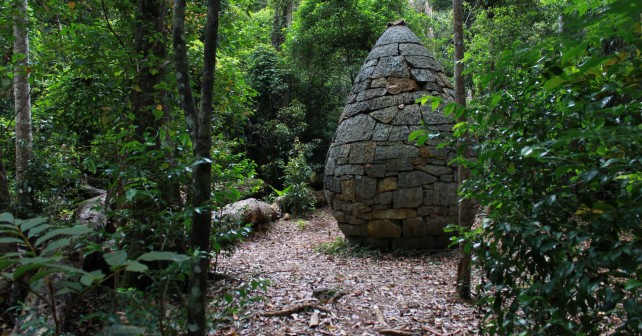Strangler Cairn bushwalk – Kenilworth
The first word to come out of my mouth when I first laid eyes on the Strangler Cairn in Conondale National Park, quite honestly, was “wow”.
I had trudged for around one hour, along rainforest tracks that were somewhat poorly maintained and lacking in signage – even getting lost at one stage – and I was feeling a little grumpy when I approached the bright open clearing that is home to what is a unique work of art.
There, the Strangler Cairn appeared suddenly through the clearing. It is an imposing sculpture, standing 3.7metres tall, in the shape of a giant egg, and created by piecing together hundreds of heavy chiselled rocks sourced from a nearby quarry.
The secluded artwork, deep in the forest, is unique in that it is not exactly finished. It will likely never be finished.
On the very top of the cairn is a Strangler Fig sapling, which has been placed here with the aim that, as it grows bigger, its roots will become entwined with the rocks and thereby influences how the structure evolves and changes over time.
Perhaps the cairn will be encased by the fig’s roots, or perhaps broken up as hair-thin roots expand and push the rocks apart – the changes are at the whim of Mother Nature.
It’s likely that this artwork will continue to evolve over decades, long after many of us have left this earth.
The sapling today is around 40cm tall, so it will take years before it has a major influence on the cairn, but that is part of the attraction. It also means repeat visitors to the structure will never quite know the changes they will notice on each return visit.
The Strangler Cairns was created in 2011 by English artist Andy Goldsworthy, who is known globally for his works created in natural and often remote environments.
The work was positioned beneath a clearing in the rainforest canopy that was caused when a massive fig crashed to the ground; fittingly, the sapling was grown from a cutting propagated from this fallen tree.
I had heard conflicting reports of the difficulties accessing the unique structure, so I decided to trek there myself and record my personal observations.
Conondale National Park is about 15 kilometres south of Kenilworth on the Maleny-Kenilworth Road.
How to get there
Firstly, the best starting point for the bush walk is from the Booloumba Creek Day Area 2. (It can also be accessed from Day Area 1, but that’s about an extra 600m walk).
The day areas are accessed via Booloumba Creek Road, which turns off the Maleny-Kenilworth Road, about 7km outside Kenilworth.
Driving from Palmwoods and taking the route through Montville and Maleny, it took me about 50 minutes to reach the turnoff. My guess is that it would be roughly the same travel time from Caloundra, for example.
An alternate route is to use the Obi Obi Road from Mapleton, but the Obi Obi Down Road remains unsealed and steep.
Booloumba Creek Road is sealed for around 4km but then becomes gravel. It’s around 2km further to the day areas.
To reach the day areas, Booloumba Creek Road crosses through two rocky creeks. I had heard conflicting advice on whether a high clearance four wheel drive was needed to cross these creeks. I was in a mid-size SUV (non 4WD) and both crossings were not difficult, although I got out and checked the water levels first and then proceeded carefully. The crossings would likely be more difficult soon after any wet weather and the water levels were higher.
There is good road signage to the entrances of both the Day Area 1 and Day Area 2. There are also camping grounds a little further along the road.
There is a third creek crossing on the short road into Day Area 2. On inspection, this creek was a little deeper, so I parked my car on the roadside and walked through the water, which was about 30cm deep, to complete the final 250metres to the starting point of the walking tracks. I wore my old runners so there was no concern about getting them wet.

Keep Informed
Stay connected and receive regular updates on what’s happening on the Sunshine Coast.
Adverise Here
Lorem ipsum dolor sit amet, consectetur adipiscing elit. Etiam iaculis ut neque non pharetra nulla.
Adverise Here
Lorem ipsum dolor sit amet, consectetur adipiscing elit. Etiam iaculis ut neque non pharetra nulla.
